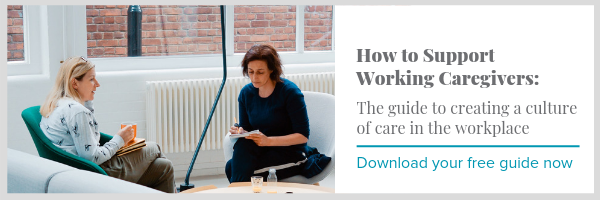Providing caregiving benefits as an employer makes economic sense and creating a culture of caring makes good social sense.
Employees who are caring for an aging adult make up 23% of the population. In addition, over 40% of adults will get diagnosed with cancer in their lifetime and 15-20% will have a child with a physical or developmental disability. When you add that all up, more than half of any workforce is experiencing the impact of distracted, absent, and stressed out employees who are providing care to a loved one. It is vital the individuals leading these employees understand how to look for signs of burnout, create an environment where caregivers are not discriminated against, and offer support resources to keep them present and engaged.
Here are the three steps to take to educate management about working caregivers' needs and to ensure your caregiving workforce is supported.
.png?width=560&name=How%20to%20Educate%20Management%20About%20Working%20Caregiver%20Needs%20(1).png)
1) Bring Awareness to Impact of Caregiving in the Workplace
The first step is to make management aware of the real issues employers face when taking an honest look at the impact of caregiving on your workforce. Caregiving doesn’t discriminate. Workers of every race, culture, gender age, and educational background find themselves in the role of caregiver. Sharing the data and making the case for the importance of supporting caregivers in the workplace is important.
2) Educate Management on Plans for Caregiving Support
Make management aware of the plan your organization has put in place to recognize and support caregivers. This plan could include a caregiver lunch and learn event or a half day workshop sponsored by your organization where education and tips are offered to empower caregivers. Sometimes a simple email at the end of the week reminding everyone to recognize their coworkers or family members who are caring for a loved one has a major impact on job satisfaction and loyalty. [Click here for more ideas on how to support your working caregivers.] Gather feedback from employees and report that feedback so your leaders know what’s working and what additional support caregivers want.
3) Educate Management on Caregiver Benefits
Lastly, educate management on the benefits your organization has available that specifically help caregivers. These can include paid time off or family leave that includes caregiving duties in addition to having a new baby. Make them aware of other benefits such as EAP services that include counseling sessions or support groups. Comprehensive solutions such as Connected Caregiving that offer technology tools, education, and peer support are a wonderful addition.
Providing your working caregivers support for the physical and emotional challenges they face will pay dividends. This guide will introduce you to the hidden, working caregivers in your organization. It will also provide a roadmap to understanding their challenges and the impact those challenges have on your organization. It will also provide you with the building blocks to begin developing a culture of caring by offering caregiving benefits.
.jpg?width=1368&name=Color-greycopy-bluealska%20(1).jpg)

